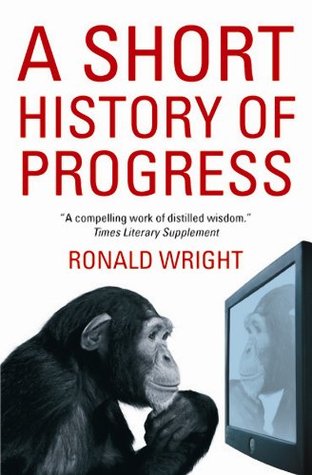More on this book
Community
Kindle Notes & Highlights
Though we became experimental creatures of our own devising, it’s important to bear in mind that we had no inkling of this process, let alone its consequences, until only the last six or seven of our 100,000 generations.
From the first chipped stone to the first smelted iron took nearly 3 million years; from the first iron to the hydrogen bomb took only 3,000.
SOMEONE FOND OF logical absurdities once defined specialists as “people who know more and more about less and less, until they know all about nothing.”
What took place in the early 1500s was truly exceptional, something that had never happened before and never will again. Two cultural experiments, running in isolation for 15,000 years or more, at last came face to face. Amazingly, after all that time, each could recognize the other’s institutions.
These studies show that the world’s climate has been unusually stable for the past 10,000 years — exactly the lifetime of agriculture and civilization. It seems we couldn’t have developed farming earlier, even if we’d tried.
Since complex life appeared, the earth seems to have averaged one cosmic bombshell every hundred million years.
In other words, two-thirds of us (or more) have lived during the last one thousandth of the human career, and about a fifth or sixth of all are living now.
The Colosseum and other Roman circuses saw bloody sacrifice on a grand scale; during the four-month games of Trajan, 5,000 men and 11,000 animals were slaughtered.
THE GREATEST WONDER of the ancient world is how recent it all is. No city or monument is much more than 5,000 years old. Only about seventy lifetimes, of seventy years, have been lived end to end since civilization began.
Easter Island punched way above its weight; but it boxed alone, as if in a looking-glass, and we have been able to replay the moves by which it knocked itself out.
Such a civilization is therefore most unstable at its peak, when it has reached maximum demand on the ecology.
On a typical second-century day, the sun would rise on Han China, pass over the Buddhist stupas of Mauryan India, glare down on the brick ruins of the Indus and Euphrates valleys, and take more than two hours to traverse the Roman lake of the Mediterranean. By the time it was noon at Gibraltar, worshippers would be greeting the dawn from the tops of pyramids in highland Mexico, the Guatemalan jungle, and the irrigated valleys of Peru.
Ancient civilizations were generally of two types — city-state systems or centralized empires — both of which arose independently in the Old and New worlds.17 With the eclipse of its republic by its empire, Rome changed from the first kind of polity into the second.
Inflation of Weimar proportions ensued. A measure of Egyptian wheat that had sold for half a denarius in the empire’s heyday cost 10,000 denarii by A.D. 338. At the beginning of the fourth century, it took 4,000 silver coins to buy one gold solidus; by the end of the century, it took 180 million.25 Citizens worn down by inflation and unfair taxation began defecting to the Goths.26
Only three ancient Maya books have survived, but they are enough to reveal the most accurate astronomy until Europe’s Renaissance, by which time Caesar’s calendar had drifted ten days out of step with the sun.
Egypt’s population growth was unusually slow. Throughout the Pharaonic, Roman, and Arabic periods, it stayed well below world average — taking 3,000 years, from the Old Kingdom to Cleopatra’s time, to rise from under 2 million to 6 million, and rising no further until the nineteenth century, when modern irrigation began.
In 3,000 years, the only major innovations were the introduction of shadduf (bucket-and-pole) irrigation about 1300 B.C. and the sagiya waterwheel about 300 B.C.
From 3000 B.C. until A.D. 1500, the world’s average growth rate was nearly 0.1 per cent (Ponting, Green History, pp. 89–90), doubling the population about every 800 years.
It took wheat 6,000 years to reach China after its domestication on the far side of the continent, hardly the rapid transit of technology in the Old World argued by Diamond (Guns, Germs, and Steel).
the New World’s true conquerors were germs: mass killers such as smallpox, bubonic plague, influenza, and measles. These arrived for the first time with the Europeans (who had resistance to them) and acted like biological weapons, killing the rulers and at least half the populations of Mexico and Peru in the first wave.11
The experiment of civilization has long had its doubters, even in times when change moved too slowly for most people to remark. The tales of Icarus, Prometheus, and Pandora illustrate the risks of being too clever by half, a theme also known to Genesis.36
Hope elects the politician with the biggest empty promise; and as any stockbroker or lottery seller knows, most of us will take a slim hope over prudent and predictable frugality.
If civilization is to survive, it must live on the interest, not the capital, of nature. Ecological markers suggest that in the early 1960s, humans were using about 70 per cent of nature’s yearly output; by the early 1980s, we’d reached 100 per cent; and in 1999, we were at 125 per cent.
By 1600, the populations of Peru and Mexico had fallen to about a million each, losses of some 95 per cent; they started to recover slightly in the eighteenth century.
Estimates for the dead of the two world wars, including victims of famine, massacre, and persecution, run as high as 187 million.


